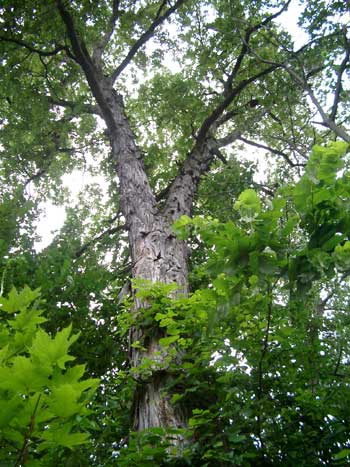- Shagbark hickory
Taxobox
name = Shagbark Hickory

image_width = 240px
regnum =Plant ae
divisio = Magnoliophyta
classis = Magnoliopsida
ordo =Fagales
familia =Juglandaceae
genus = "Carya"
species = "C. ovata"
binomial = "Carya ovata"
binomial_authority = (Mill.) K.KochThe Shagbark Hickory ("Carya ovata") is a common
hickory in the eastern United States and southeastCanada . It is a largedeciduous tree , growing up to 27 m tall, and will live up to 200 years old. Mature Shagbarks are easy to recognize because, as their name implies, they have shaggy bark. This character is however only found on mature trees; young specimens have smooth bark.The shagbark hickory's nut is edible and has a very sweet taste.
The leaves are 30-60 cm long, pinnate, with five (rarely three or seven) leaflets, the terminal three leaflets much larger than the basal pair. The
flower s are small wind-pollinatedcatkin s, produced in spring. Thefruit is adrupe , an edible nut, 2.5-4 cm long contained in a thick green four-sectioned husk which turns dark and splits off at maturity in the fall and a hard, bony shell. [http://www.hiltonpond.org/ThisWeek030908.html] There are two varieties:
*"Carya ovata" var. "ovata" (Northern Shagbark Hickory). Largest leaflets over 20 cm long; nuts 3-4 cm long.
*"Carya ovata" var. "australis" (Southern Shagbark Hickory or Carolina Hickory). Largest leaflets under 20 cm long; nuts 2.5-3 cm long.Some sources consider Southern Shagbark Hickory as the separate species "Carya carolinae-septentrionalis" [http://www.cas.vanderbilt.edu/bioimages/species/caca38.htm] [http://www.itis.usda.gov:8080/servlet/SingleRpt/SingleRpt?search_topic=TSN&search_value=501307]
Uses
The nuts are edible with an excellent flavor, and are a popular food among those who know them. The trees bear too seldom for them to be grown commercially.Shagbark Hickory
wood is used for smokingmeat and for making the bows of Native Americans of the northern area."Hickory" is derived from pawcohiccora, an Algonquin Indian word for the tree's oily nutmeat. [http://www.hiltonpond.org/ThisWeek030908.html] The nuts were a food source for Native Americans. [http://aggie-horticulture.tamu.edu/carya/species/ovata/ovata.htm]
Hickory Syrup
The bark of the Shagbark Hickory is also used to flavour a maple syrup-style sugar syrup.
External links
* [http://www.na.fs.fed.us/pubs/silvics_manual/volume_2/carya/ovata.htm USDA forest service description]
* [http://www.efloras.org/florataxon.aspx?flora_id=1&taxon_id=233500320 Flora of North America: "Carya ovata"]
* [http://www.cas.vanderbilt.edu/bioimages/pages/carya-compare-shag.htm Comparison of Shagbark, Southern Shagbark, and Kingnut Hickory at bioimages.vanderbilt.edu]
* [http://www.cas.vanderbilt.edu/bioimages/species/frame/caov2.htm "Carya ovata" (= "Carya ovata" var. "ovata ") images at bioimages.vanderbilt.edu]
* [http://www.cas.vanderbilt.edu/bioimages/species/frame/caca38.htm "Carya carolinae-septentrionalis" (= "Carya ovata" var. "australis ") images at bioimages.vanderbilt.edu]
* [http://www.cirrusimage.com/tree_shagbark_hickory.htm Shagbark Hickory - large format diagnostic photos tree, leaves, bark, nuts]
* [http://www.sankey.ws/crf/lavant.html The Lavant shagbarks]
*http://whatscookingamerica.net/Stores/HickorySyrup.htm
*http://www.hickoryworks.com/
Wikimedia Foundation. 2010.
